 |
| Category:
Conflicts/Others |

|
|
|
|
|
|
The Crimean War
1854/56 and Australian Involvement
|
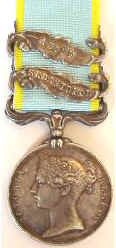 |
In 1853, Russia sent troops to defend
Christians within the Ottoman Empire. Within months, Russian troops had
occupied parts of the Ottoman Empire and the Turks declared war on Russia
. On 28
March 1854, looking to prevent Russian expansion, Britain and France (with
Austrian backing) also declared war on Russia.
In September 1854, Allied
troops invaded the Crimea and within a month were besieging the Russian
held city of Sebastopol. |
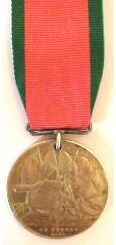 |
| British Crimea
medal |
Turkish Crimea medal |
 |
Sydney, NSW. c. 1880. Studio
portrait of Charles Dalton, wearing the uniform of the 8th King's
Royal Irish Hussars.
Born in London on 24 November
1832, he served in the Crimea and Turkey at Alma, Balaclava,
Inkerman and Sebastapol and took part in the charge of the Light
Brigade.
He also served in India at
the Siege of Kotah, recapture of Chundaree Kotah Ki Seari, capture
of Gwalior Powrie, Sindwah and Koonoyr.
He spent twenty five years in
charge of the Governor's Escort in New South Wales and died in
Balgowlah, NSW, on 5 February 1891.
His grandson 96 Sergeant
Trumpteter Clive M. Dalton, 4th Light Horse Brigade, died of wounds
received at Gallipoli on 12 August 1915 (Donor M.
Aspinall). |
On 25 October 1854, the Russians were
driven back at the Battle of Balaclava (including the foolhardy Charge of
the Light Brigade). Eleven days later, the Battle of Inkerman was also
fought (with high casualties on both sides). Poorly supplied and with
little medical assistance (despite the self-publicity of Florence
Nightingale), the British troops suffered immense casualties - 4,600 died
in battle; 13,000 were wounded; and 17,500 died of disease.
|
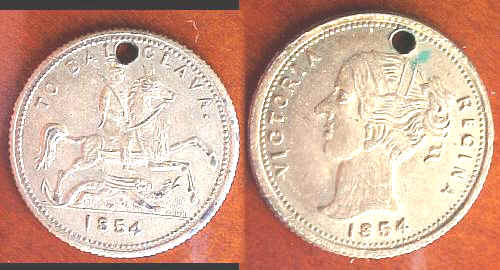
|
| On the obverse is a Young Queen
Victoria. On the reverse, a British Cavalryman charging over the
dragon serpent that is Russia. At the top of that is "TO
BALACLAVA!". This 1854 medallion is 23mm or almost an inch in
diameter. |
The French and British forced the fall
of Sebastopol on 11 September 1855 and peace was subsequently concluded at
Paris. Within fifteen years, the Russian were back in Sebastopol and
rearming.
|
| Interesting
Side Note 1:It was the first war where the electric
telegraph started to have a significant effect; the first 'live' war
reporting to The Times, and British generals' reduced
independence of action from London due to such rapid communications.
Newspaper readership informed public opinion in Britain and France as
never before.
|
Interesting
Side Note 2: The Crimean War occasioned the
invention of hand rolled "paper cigars" - cigarettes - by French
and British troops who copied their Turkish comrades in using old
newspaper for rolling when their cigar-leaf rolling tobacco ran out or
dried and crumbled.
|
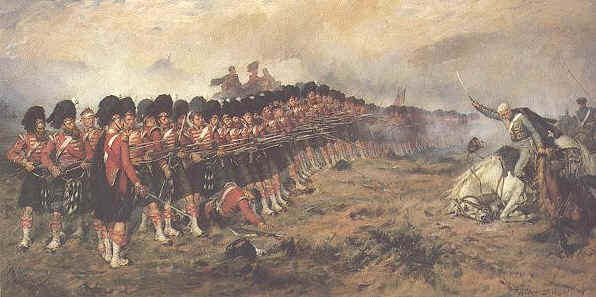
|
| The Thin
Red Line - Original painting by Robert Gibb. The
93rd Sutherland Highlanders facing Russian cavalry at the Battle of
Balaklava 1854.
|

|
Diplomatic Prelude
As he had on other occasions, Nicholas I
tried again in 1853 to get an understanding with England about the
position of Turkey and to prevent a rapprochement between England and
France. The Russians would not tolerate the establishment of the English
in Constantinople, but did not want to annex the city either. Temporary
occupation by Russia might, however, be necessary to secure Russia's aim
of finally getting secure outlet from the Black Sea. In discussions with
Foreign Minister Russell of Britain Russia suggested an independent
Moldavia and Wallachia, a Serbia under Russian protection, and an
independent Bulgaria. The English were to get Egypt and Crete. The
Austrians could establish themselves on the Adriatic.
| Russell rejected the
"offer" and said that France would have to be consulted on
the matter.
Nicholas I, however, was under the
erroneous impression that some sort of "new system"
existed as a result of Nesselrode's Memorandum of 1844, which had
suggested a arrangement with regard to the Straits.
This particular memorandum and the
substance of the current diplomatic conversations with British
Ambassador Seymour in St. Petersburg were published by Britain and
touted as proof that "dark ambitions of a foreign despot"
were endangering the peace of Europe. |
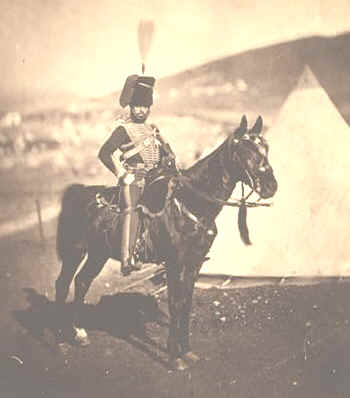 |
Immediate Cause
The Franco-Russian dispute over the holy
places in Palestine was the immediate cause of the Crimean War. At the
time Turkey controlled Palestine, Egypt, and large chunks of the Middle
East. The Port (Moslem ruler of Turkey) had given privileges to protect
the Christians and their churches in the Holy Land to many nations. That
explains why so many different churches and nationals control various holy
shrines in Israel to this very day. At the time France and England had
gotten more specific commitments from the Port than other nations.
France's interest in Palestine had been stimulated by a domestic crisis in
1840-1841. Napoleon II pushed it because he relied on the support of
militant clerical groups in France. In 1850 Napoleon III requested the
restoration to French Catholics of the capitulations of 1740. This meant
that the French wanted the key to the Church of the Nativity in the old
city of Jerusalem and the right to place a silver star on Christ's
birthplace in Bethlehem. The French threatened military action if the
Porte did not give way and the Russians threatened to occupy Moldavia and
Wallachia if he did. The weak Porte did the best he could under the
circumstances and gave a yes answer to foreign parties. This bit of
typical Turkish duplicity was soon discovered. When it was discovered the
French send the warship Charlemagne to Constantinople and a squadron of
ship the Bay of Tripoli. In December 1852, having no other choice, the
Porte gave in to Paris.
In February Nicholas responded by mobilizing two army corps and sending
his ambassador, Menshikov, to Constantinople. Menshikov demanded not only
the restoration of Greek rights but also a secret alliance and the
protection of all orthodox laymen under Turkish rule-that meant some 12
million subject of the Porte. At this point the British got into the act
in the person of a very clever diplomatic operator in Constantinople by
the name of Stratford de Redcliffe. The latter outfoxed Menshikov who got
concessions on the Greek rights issue but non of the other demands. So
Meshikov went home.
It seems silly to us today that they argued over the keys to a church, but
then it was not just any church. And besides, the religious issue was not
the essential factor in the Franco-Russian dispute. France wanted to break
down the continental alliance that had paralyzed her for half a century.
National interests were involved here. England and France, in particular
responded to popular sentiment stirred up by liberal and patriotic groups
in their countries. Financial and trading groups, as always, were involved
as well. Such pressure is not evident in the case of Russia. The Black Sea
trade at this time was still quite insignificant.
When the Menshikov Mission became public
knowledge it strengthened the anti-Russian faction in the British cabinet.
So the British decided it was worth a war to keep and expand their
interest in the Eastern Mediterranean. In June 1853 an Anglo-French naval
force entered the Dardanelles. In July the Russian army invaded the
principalities of Moldavia and Wallachia (modern day Rumania).
The war could still have been prevented. There were 11 different project
for pacification at the end of 1853. But the only important one was the
so-called "Vienna Note" to Turkey and Russia by France, Austria,
Prussia, and England. The Porte was to promise no change in the status quo
without the explicit consent of France and Russia. Russia accepted this
condition, but Turkey naturally rejected it. Nicholas I and Francis Joseph
of Austria even had a personal summit at Olmütz. Nicholas promised not to
intervene in Turkey or to extract some right to protect orthodox
Christians under Turkish, like in the famous Treaty of Kuchuck Kainardje.
The English, however, turned this deal down.
|
The following letter to the editor appeared in the SMH
early last century.
Sydney Morning Herald, Monday, May 1, 1911
THE OLDEST VOLUNTEER
(letter)
"TO THE EDITOR OF THE HERALD
Sir, I have noticed several letters in your paper claiming the above
title. During the Crimean War, in 1854, a volunteer force of
cavalry, artillery and infantry respectively was formed: I joined the
cavalry under Captain Macdonald, an Imperial officer from India. We
were sworn in and took the oath of allegiance by Major Cockburn at
his office which was then on the first floor at the southern end
where the Sydney Mint is now. I still have in my possession the
forage cap worn by me. We had to find our own uniforms, which were
expensive, as also horse and accoutrements. When peace was
proclaimed I joined the First infantry Regiment in 1867, and had
33.5 years' service altogether. I think it will be very difficult to
beat my claim, at all events, to be one of the oldest volunteers now
living.
I am, etc.,
J.H. MORRIS
Lieut. Col., V.D."
I found this soldier in the NSW Govt's "1894 BLUE BOOK" on page
50, as a
Major in the Military Forces - Infantry - 1st Regiment.
The Blue book states he joined the NSW Govt Military establishment on Feb
14, 1871 and was promoted to his then current position of Major on the Nov
15, 1888.
-
Can you please give me other information about this officer?
-
i.e. What other wars did he fight?
- when was he promoted to Lt Col?
- when did he leave the military?
- what is his military history?
- etc
Thank you for your assistance with this matter.
All the Best
J J Mitchell
|
|
The Crimean
War: an overview
from http://www.geocities.com/Broadway/Alley/5443/crimwar1.htm
In the years 1854 to 1856, Britain fought its only European war between
the ending of the Napoleonic conflict in 1815 and the opening of the
Great War in 1914. Although eventually victorious, the British and their
French allies pursued the war with little skill and it became a byword
for poor generalship and logistical incompetence.
The war began as a quarrel between Russian Orthodox monks and French
Catholics over who had precedence at the holy Places in Jerusalem and Nazareth.
Tempers frayed, violence resulted and lives were lost. Tsar Nicholas I
of Russia demanded the right to protect the Christian shrines in the
Holy Land and to back up his claims moved troops into Wallachia and
Moldavia (present day Rumania) then part of the Ottoman Turkish empire.
His fleet then destroyed a Turkish flotilla off Sinope in the Black Sea.
In an early instance of propaganda, British newspaper reports of the
action said the Russians had fired at Turkish wounded in the water.
Russian domination of Constantinople and the Straits was a perennial
nightmare of the British and with the two powers already deeply
suspicious of each others intentions in Afghanistan and Central Asia,
the British felt unable to accept such Russian moves against the Turks.
Louis Napoleon III, emperor of France, eager to emulate the military
successes of his uncle Napoleon I and wishing to extend his protection
to the French monks in Jerusalem allied himself with Britain. Both
countries dispatched expeditionary forces to the Balkans. The British
was commanded by Lord Raglan, who had last seen action at the Battle of
Waterloo; the French by General St. Arnaud and, after his death from
cholera, General Canrobert both veterans of France's Algerian wars.
The war began in March 1854 and by the end of the summer, the
Franco-British forces had driven the Russians out of Wallachia and
Moldavia. The fighting should have ended there, but it was decided that
the great Russian naval base at Sevastopol was a direct threat to the
future security of the region and in September 1854 the French and
British landed their armies on the Crimean peninsula.
From their landing beaches the allies marched southward to invest
Sevastopol. On the way they fought their first major battle. At the
River Alma, a Russian army tried unsuccessfully to prevent the Allies
crossing the river and scaling the heights beyond. The defeated Russians
retreated inland and as the siege of Sevastopol began a regrouped
Russian army hovered menacingly on the flank of the British army who
were using the inlet of Balaklava as its supply harbour. Sevastopol was
invulnerable to any kind of sea borne attack and her landward defences
were also formidable. Soon the major strong points in the defences, the
Redan, the little Redan and the Malakoff bastion, would become household
words in Britain.
As the British and French prepared their siege works the Russian army on
the British right flank struck. They were flung back at this the Battle
of Balaklava but only with great loss and the near annihilation of the
British light cavalry. A further attempt by the Russians resulted in the
Battle of Inkerman, a murderous fistfight fought out in a fog so thick
that sometimes the troops could only see a few yards ahead. again the
Russians were pushed back.
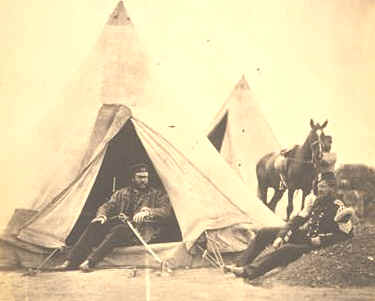 |
The war settled down
to one of spade and artillery as the Allies pushed their trenches
nearer the defensive lines of Sevastopol.
The winter of 1854-55 brought
great misery to the troops, particularly the British as their commissary
department was grossly incompetent and for months the men were
clothed in rags, cold, hungry and short of everything. |
The only bright light in this sorry
tale of official negligence and stupidity was the work of Florence
Nightingale who almost single-handedly drastically cut mortality rates
for the British wounded at the hospital in Scutari.
Finally, in early 1856, Sevastopol fell and the war was brought to a
conclusion by the Peace of Paris. |
|
Battle of Balaklava & The Charge of the Light Brigade |
|
as well as the less
well known but much more successful |
|
The Charge of the Heavy
Brigade |
|
It was the Russian army hanging on the
flank of the British that caused the second of the Crimean War's
battles, the Battle of Balaklava. North of Balaklava harbour was a
slight rise where the 93rd Highlanders had made their camp. Beyond this
there lay the South Valley, an open valley leading up to a higher
line of hills known as the Causeway Heights. The Causeway Heights looked
down on a narrower valley called the North Valley and beyond it the
Fedoukine Hills. It was in the North Valley that the greatest spectacle
and most tragic event of the war would take place - the charge of the
Light Brigade.
Along the crest of the Causeway Heights were a string of six redoubts
manned by Turkish infantry. On the morning of 25th October, 1854 they
were approached by a massively superior force of Russian troops well
supported by artillery. the Turks held their ground as frantic
messengers run back to warn the British. Unfortunately, the British
reacted very slowly and by the time they had started across the South
Valley the Turks were in full flight, four of the redoubts in enemy
hands and Russian cavalry was swarming over the Causeway Heights. Soon
they approached the 93rd Highlanders under the command of Sir Colin
Campbell , later famed for his relief of Lucknow in the
Indian Mutiny . Campbell ordered his men to stand firm and die if they
must in their places in the line. There could be no retreat as they were
all that stood between the enemy and the disorganized British camp. Hold
they did and in such a fashion that Times correspondent William
Russell, watching from the hills above, was moved to coin the immortal
phrase 'a thin red line tipped with steel'. Shortened to 'the thin red
line' his phrase came to forever symbolize the stoicism and
imperturbability of British troops when faced with superior numbers.
|
The Heavy Brigade and
their successful charge |
|
Though the Highlanders drove off the Russian cavalry on their front, a
larger body of Russian horsemen were moving up the North Valley in the
direction of the British H.Q.. Disturbed by the fire of a British gun,
they crossed over the Causeway Heights to the left of the Highlanders
and saw below them the Heavy Brigade, six squadrons of British heavy
cavalry from the Royal Scots Greys, the Inniskilling Dragoons and the
Dragoon Guards.
|
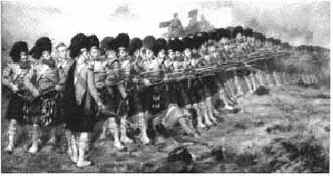
|
The Russians were a dense grey mass all wearing
yellowish-grey greatcoats and the British cavalry approaching them in
lines of absurd thinness must have seemed hopelessly fragile, even
effete, in their bright scarlet tunics.
They were led by the aptly named
General Sir James Scarlett, 55 years old, who had never ever commanded
troops in battle. He was to show this day that he had a certain flair
for such things. Taking his time to dress his men into perfect lines and
ignoring an order to charge immediately, Scarlett organised his
squadrons as if on parade. The Russian cavalry, from the slopes of the
Causeway Heights watched with incredulous fascination. There had been no
British cavalry charges so far in the war and only a fool would
countenance such an action now, against a much stronger enemy.
Scarlett's trumpeter sounded the charge and his men moved off. The Scots
Greys wore heavy bearskins, the Iniskillings and the Dragoon Guards
embossed helmets. If not the finest cavalry in the world they were
certainly amongst the best attired. As they drove into the Russian line
the red tunics seemed to disappear in a sea of Russian grey. There was
no room for fancy swordsmanship and the troopers hacked about them as if
with meat cleavers. The ferocity, execution and sheer arrogance of the
charge, however, were too much for the Russians and they faltered. Then
they broke and fled northwards back over the Causeway Heights.
- It was not the most spectacular charge ever made by British cavalry, but
it was probably the most effective.
As the Russians retreated and the
wounded were being carried back to camp, an A.D.C. of Lord Raglan the
British commander-in-chief trotted up and handed Scarlett a note. The
exhausted Scarlett read the note and quickly turned away to hide the
moistening of his eyes. The note read simply, "Well done,
Scarlett." Raglan was not so pleased with Lord Cardigan, the leader
of the Light Brigade, who let had a golden opportunity slip by not pursuing
the Russians the Heavy Brigade had put to flight. The focus of the
battle now moved over to the western end of the North Valley were the
Light Brigade were positioned and a crucial factor came into play.
The
topography of the battlefield, with its hills and valleys, made it very
difficult for officers in the field to see much more than what was on
their direct front whereas the generals watching from the hills above
enjoyed an almost unimpeded view. As the Heavy Brigade reformed and
British infantry advanced on the westernmost of the captured redoubts,
Lord Raglan ordered Lord Lucan, the overall commander of the cavalry, to
take any advantage given and advance with infantry support to regain
possession of the heights. Lucan could see no sign of the promised
infantry support and declined to move. Lord Raglan fumed with impatience
at this inactivity and just then the critical event occurred. The
Russians brought up artillery horses to the captured redoubts obviously
intending to remove their guns. Determined not to allow this to happen,
Raglan sent Lucan an order telling him to prevent the removal of the
guns.
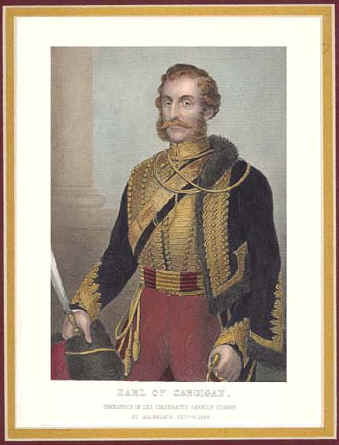 |
Lucan conferred with Cardigan, his brother-in-law and a man he heartily
detested. It was Cardigan's Light Brigade that would have to lead any
forward movement. Unfortunately, the only guns that either of them could
see were the Russian artillery, a mile away, at the eastern end of the
North Valley.
Supported by massed infantry and cavalry and with other
guns and riflemen on both sides of the valley, the Russian position was
unassailable - a three-sided trap like the jaws of some ferocious beast.
Cardigan mildly protested at the folly of charging such a position, but
Lucan reminded him that he had a direct order in writing from the
commander-in-chief. Unwilling to disobey a direct order, neither Lucan
nor Cardigan made any attempt to verify whether Raglan really wanted
them to make such a suicidal effort.
|
|
The Light Brigade and
its spectacular and disastrous charge |
Cardigan sounded the charge and the
Light Brigade started forward. The first line consisted of the 13th
Light Dragoons on the right, the 17th Lancers on the left and the 11th
Hussars in support. The second was formed by the 4th Light Dragoons and
the 8th Hussars. Cardigan rode well in front of the first line and for
all his faults there is no doubting his courage. 673 men rode forward
when the trumpet sounded. Less than 200, almost all of them wounded,
would return.
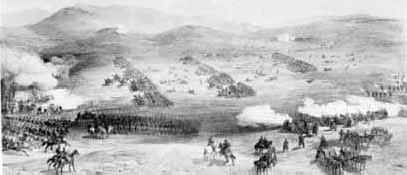 For the first fifty yards nothing happened and Lord Cardigan in his blue
and cherry coloured uniform and gold trimmed pelisse looked, as Lord
Raglan said, "as brave and as proud as a lion." Then the
Russian guns opened up. The horses began to move faster from a trot to a
canter to a gallop and the officers had trouble restraining some of
their men from spurring on ahead. From three sides a storm of lead and
iron winnowed the ranks of the British. The spectacle was incomparable
and on the hills above a British officer burst into tears at the sight
of such a suicidal tragedy. An elderly French general trying to comfort
him said, "Pauvre garcon. Je suis vieux, j'ai vu des batailles,
mais ceci de trop." Barely fifty men of the first line reached the
Russian guns. They rushed past, slashing at those gunners who had been
slow to find cover, and slammed into the Russian cavalry behind the
guns. They drove it backwards in disorder until overwhelming numbers
slowed the momentum of their charge and they were forced to retire. The
second line slaughtered the Russian gunners and pushing forward were met
by the remnants of the first line in retreat.
For the first fifty yards nothing happened and Lord Cardigan in his blue
and cherry coloured uniform and gold trimmed pelisse looked, as Lord
Raglan said, "as brave and as proud as a lion." Then the
Russian guns opened up. The horses began to move faster from a trot to a
canter to a gallop and the officers had trouble restraining some of
their men from spurring on ahead. From three sides a storm of lead and
iron winnowed the ranks of the British. The spectacle was incomparable
and on the hills above a British officer burst into tears at the sight
of such a suicidal tragedy. An elderly French general trying to comfort
him said, "Pauvre garcon. Je suis vieux, j'ai vu des batailles,
mais ceci de trop." Barely fifty men of the first line reached the
Russian guns. They rushed past, slashing at those gunners who had been
slow to find cover, and slammed into the Russian cavalry behind the
guns. They drove it backwards in disorder until overwhelming numbers
slowed the momentum of their charge and they were forced to retire. The
second line slaughtered the Russian gunners and pushing forward were met
by the remnants of the first line in retreat.
Lord George Paget, commander of the
second line, on being informed that Russian lancers were closing in
behind them shouted, "Halt boys, halt front, if we don't halt now
we're done!" His men obeyed and turned their weary horses back down
the valley up which they had charged at such cost. As they retired the
Russian lancers seemed to part to let them through with just a few
desultory lance prods to see them on their way. Some said this was a
Russian gesture of respect for the heroism of the charge. Some said it
was the result of the ineffectual leadership that was apparent in the
handling of Russian cavalry. Perhaps it was simply the ordinary Russian
troopers disdaining to risk their lives against an obviously spent force
that had shown such a proclivity to insanity. More than 500 British
horses died in the charge and it's possible the Russians just felt sorry
for the surviving mounts.
The
Battle of Balaklava was claimed as a victory by the British but in
reality it was not so. British cavalry played were unable to play any
significant role for the remainder of the war and the Causeway Heights
were left in Russian hands. This would greatly add to the misery of the
British Army as it faced the Crimean winter. |
|